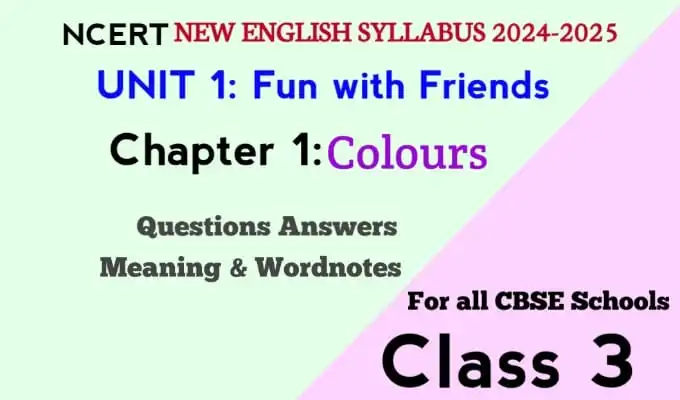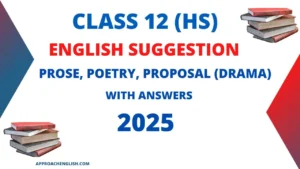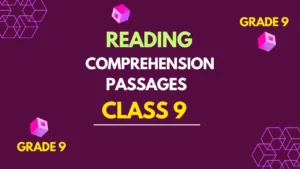Chapter 1 Colours in CBSE Class 3 English, part of the NCERT-designed textbook “Santoor, forms an integral part of the grade 3 English curriculum beginning from the 2024-2025 session in all CBSE schools nationwide. This chapter aims to familiarize students with colors through interactive exercises and question-answer sessions.
Here in this article, The NCERT-designed English textbook “Santoor” for Grade 3 introduces Chapter 1, “Colours,” in line with NEP 2020 and NCF for School Education 2023.
All textual Questions Answers with meanings and Word notes are here provided from Chapter 1 Colours in CBSE Class 3 English starting from the 2024-2025 session.
Unit 1: Fun with Friends
[For pictures, see The textbook, Santoor for Grade 3; Pages no 1 & 2 NCERT 2024]
Picture reading
Duck: Come dear hen, let us go to the village fair.
Hen: All right. Let me bring my chicks.
Duck: Come ducklings, let us go.
Ducklings: We have reached the stream.
Chicks: I cannot swim. How shall we cross the stream?
Duck: I have a plan …
Page No 3
Now discuss it with your friends.
1. How many ducklings and chicks can you see in the picture?
Ans: There are three ducklings and three chicks I can see in the picture.
2. The duck and the hen — are they friends? How do you know?
Ans: Yes, the duck and the hen are friends. In the picture, I see that the duck is helping the hen and her chicks cross the stream taking them on their back.
3. How did the hen and the chicks cross the stream?
Ans: The hen and the chicks crossed the stream on the backs of ducks and ducklings.
4. Have you ever helped your friend? How did you help?
Ans: Yes, I have helped my friend. Once, my best friend forgot to bring his/her textbook to English Class. I borrowed him/her my textbook during the English period as I had two sets.
5. Did you feel happy to help your friend?
Ans: Yes. I felt very happy to help my friend.
6. Match the following animals with their young ones
| Animals | Young ones |
| Duck | Duckling |
| Hen | Chicks |
| Cow | Calf |
| Cat | Kitten |
| Dog | Puppy |
People also ask
| Chapter 5: Talking Toys | |
| Chapter 3: Best Friends | Chapter 4: Out in the Garden |
| Chapter 1: Colour | Chapter 2: Badal and Moti |
Chapter 1. Colours
You have a few crayons,
Red, yellow and blue.
Green, purple and black,
I have some too.
I need the red
and you need the black.
If we share our crayons,
we have a full pack!
Word Meaning:
crayons (क्रेयॉन) – a pencil or stick of colored chalk or wax, used for drawing – रंगीन चाक या मोम की एक पेंसिल या छड़ी, जिसका उपयोग चित्रांकन के लिए किया जाता है।
a few – कुछ – some
अनुबाद:
आपके पास कुछ क्रेयॉन हैं,
लाल, पीला और नीला.
हरा, बैंगनी और काला,
मेरे पास भी कुछ हैं.
मुझे लाल चाहिए
और तुम्हें काले रंग की जरूरत है.
यदि हम अपने क्रेयॉन साझा करते हैं,
हमारे पास पूरा पैक है!
Page 5:
A. Answer the questions. Write your answer in the given space. [प्रश्नों के उत्तर दें। अपना उत्तर दिए गए स्थान पर लिखें।]
1. How many children are there in the poem? [कविता में कितने बच्चे हैं?]
Ans: There are two children in the picture.[तस्वीर में दो बच्चे हैं.]
2. Why did the children want to share the crayons? [च्चे क्रेयॉन क्यों बाँटना चाहते थे?]
Ans: The children can get a complete set of crayons by sharing. They have colors each other needs, so sharing gives them all. [बच्चे साझा करके क्रेयॉन का पूरा सेट प्राप्त कर सकते हैं। उनके पास एक-दूसरे के लिए आवश्यक रंग हैं, इसलिए साझा करने से उन्हें सब कुछ मिल जाता है।]
3. How can the children in the poem have a full pack? [कविता में बच्चों के पास पूरा पैक कैसे हो सकता है?]
Ans: The children can have a full pack of crayons by sharing. By sharing their crayons, they collectively possess all the colors they need, thus making a full pack. [बच्चे साझा करके क्रेयॉन का पूरा पैक प्राप्त कर सकते हैं। अपने क्रेयॉन को साझा करके, उनके पास सामूहिक रूप से वे सभी रंग होते हैं जिनकी उन्हें आवश्यकता होती है, इस प्रकार एक पूर्ण पैक बन जाता है।]
B. Think and say.
1. The children in the poem shared their crayons. Do you share anything with your friends? What do you share? [कविता में बच्चों ने अपने क्रेयॉन साझा किए। क्या आप अपने दोस्तों के साथ कुछ भी साझा करते हैं? आप क्या साझा करते हैं?]
Ans: Yes, I share things with my friends. We often share toys, books, and sometimes snacks during break time. [हां, मैं अपने दोस्तों के साथ चीजें साझा करता हूं। हम अक्सर ब्रेक टाइम के दौरान खिलौने, किताबें और कभी-कभी स्नैक्स साझा करते हैं।]
2. You have only green, blue and red crayons. Talk in pairs what you would want to draw. [आपके पास केवल हरे, नीले और लाल क्रेयॉन हैं। जोड़ियों में बात करें कि आप क्या बनाना चाहते हैं।]
Ans: With green, blue, and red crayons, I might want to draw a colorful rainbow or a beautiful ocean scene with fishes and waves. [हरे, नीले और लाल क्रेयॉन के साथ, मैं एक रंगीन इंद्रधनुष या मछलियों और लहरों के साथ एक सुंदर समुद्र का दृश्य बनाना चाह सकता हूं।]
3. Now you have blue, green, red, yellow, brown and orange crayons. What can you draw? Draw here: [अब आपके पास नीले, हरे, लाल, पीले, भूरे और नारंगी रंग के क्रेयॉन हैं। आप क्या बना सकते हैं? यहां ड्रा करें:]
Ans: With blue, green, red, yellow, brown, and orange crayons, I could draw a vibrant landscape with a blue sky, green trees, a red barn, yellow sun, brown soil, and orange flowers blooming. [नीले, हरे, लाल, पीले, भूरे और नारंगी रंग के क्रेयॉन के साथ, मैं नीले आकाश, हरे पेड़, लाल खलिहान, पीला सूरज, भूरी मिट्टी और खिलते नारंगी फूलों के साथ एक जीवंत परिदृश्य चित्रित कर सकता हूं।]
Page 6:
a) LEBU – Ans: BLUE – नीला
b) LYLEWO – Ans: YELLOW – पीला
c) RENEG – Ans: GREEN – हरा
d) RUPPEL – Ans: PURPLE – बैंगनी
e) NROBW – Ans: BROWN – भूरा
A. Say aloud.
This is a green crayon. [यह एक हरा क्रेयॉन है.]
The word green begins with ‘gr’. [हरा शब्द ‘ग्र’ से शुरू होता है।]
The word crayon begins with ‘cr’. [क्रेयॉन शब्द ‘सीआर’ से शुरू होता है।]
Now say these words aloud: [अब ये शब्द ज़ोर से बोलें:]
| gr | green(ग्रीन) | green | greyगरे | Grassग्रैस | Grapesग्रपस | grandmotherग्रांडमोथेर |
| cr | crayonक्रैआन | crabक्रैब | craneक्रैन | crow क्रो | cradle क्रेडएल | |
| dr | draw ड्रॉ | drum ड्रम | dressड्रेस | dropड्रॉप | dragon ड्रैगन | |
| pr | princeप्रिन्स | princessप्रिंसेस | prizeप्राइज़ | prayप्रे | presentप्रेजेंट |
Form a sentence using each of these words and say it aloud.
green – I have bought a green pencil. [मैंने एक हरा पेंसिल खरीदी है।]
grey – I don’t like to use grey colour. [मुझे ग्रे रंग का उपयोग करना पसंद नहीं है।]
grass – The cow eats grass. [गाय घास खाती है।]
grapes – The fox can not get the grapes. [लोमड़ी अंगूर नहीं पा सकती।]
grandmother – My grandmother is a very funny woman. [मेरी दादी एक बहुत हास्यास्पद महिला है।]
crayon – I like to share crayons with my friends. [मुझे अपने दोस्तों के साथ क्रेयॉन साझा करना पसंद है।]
crab – I saw a crab on the beach. [मैंने समुद्र तट पर एक केकड़ा देखा।]
crane – Crane likes to eat fish. [क्रेन मछली खाने का शौकीन है।]
crow – A Crow is called a ‘sweeper bird’. [एक कौआ ‘स्वीपर बर्ड’ कहलाता है।]
cradle – My little sister sleeps on the cradle. [मेरी छोटी बहन को झूले पर सोती है।]
draw – I like to draw a tiger. [मुझे एक बाघ ड्रा करना पसंद है।]
drum – My friend does not like the sound of the drum. [मेरे दोस्त को ढोल की ध्वनि पसंद नहीं है।]
dress – My brother bought a new dress. [मेरा भाई ने एक नया पोशाक खरीदा।
drop – I like to watch drops of rain. [मुझे बारिश की बूंदों को देखना पसंद है।]
dragon – My friend likes to draw a picture of a dragon. [मेरे दोस्त को एक ड्रैगन का चित्र बनाना पसंद है।]
prince – We read a story of a prince. [हमने एक राजकुमार की कहानी पढ़ी।]
princess – The princess fell into a ditch. [राजकुमारी एक खाई में गिर गई।]
prize – I have won the prize. [मुझे पुरस्कार जीत लिया है।]
pray – I always pray to God. [मैं सदैव ईश्वर से प्रार्थना करता हूँ।
present – Today, I am present in the class. [आज मैं कक्षा में उपस्थित हूं।]
Page 7:
B. Have fun!
Here is a fun task for you!
Look at the words. Read out the COLOUR but not the words.
For example:
The word ‘yellow’ is written in green colour, so you should read YELLOW as GREEN instead of YELLOW.

A. Words used to show actions are called action words. Read the words given below. Circle the action words.
Page 8:
B. Find the action words in the grid below. One is done for you.

C. There are 26 letters in the English alphabet. They are:
| A ए | B बी | C सी | D डी | E ई | F एफ | G जी |
| H एच | I आई | J जे | K के | L एल | M एम | N एन |
| O ओ | P पी | Q किउ | R अर | S एस् | T टि | U ईउ |
| V भी | W दोबलू | X एक्स | Y ओआई | Z जेड |
English Alphabet with Sentences
| A | Anu eats an apple. [अनु एक सेब खाती है।] |
| B | Basu has a bat and a ball. [वोसु के पास एक बल्ला और एक गेंद है।] |
| C | Chandu likes cabbage and carrots.[चंदू को पत्तागोभी और गाजर पसंद है।] |
| D | Dinesh dances day and night.[दिनेश दिन-रात नाचता है।] |
| E | Esha enjoys an elephant ride. [ईशा को हाथी की सवारी बहुत पसंद है।] |
| F | Faiz feeds a fish.[फैज़ एक मछली को खाना खिलाता है] |
| G | Govind goes to get guavas.[गोविंद अमरूद लेने जाता है।] |
| H | Hari helps Hemant.[हरि, हेमन्त की मदद करता है।] |
| I | I like ice-cream.[मुझे आइसक्रीम पसंद है।] |
| J | Jack just jumps down.[जैक बस नीचे कूद जाता है.] |
| K | Kavita keeps the kittens on her knees. [कविता बिल्ली के बच्चों को घुटनों पर रखती है] |
| L | Lata loves lemonade. [लता को नींबू पानी बहुत पसंद है] |
| M | Madhav mixes milk and mango pulp.[माधव दूध और आम का गूदा मिलाता है।] |
| N | Navneet writes his name on new notebooks.[नवनीत नई नोटबुक पर अपना नाम लिखते हैं।] |
| O | Om opens a box of oranges.[ओम संतरे का एक डिब्बा खोलता है।] |
| P | Prema puts a pencil in her pocket.[प्रेमा अपनी जेब में एक पेंसिल रखती है।] |
| Q | Queue up quietly.[चुपचाप कतार में लग जाओ.] |
| R | Radha rolls the red ribbon. [राधा लाल रिबन लपेटती है] |
| S | Six sparrows sit on a sack. [एक बोरे पर छह गौरैया बैठती हैं।] |
| T | The teacher tells a tale. [शिक्षक एक कहानी सुनाता है. |
| U | Usha uses an umbrella. [उषा छाते का उपयोग करती है। |
| V | Vishnu visits a village in a van. [विष्णु एक वैन में एक गाँव का दौरा करता है। |
| W | We see a watchman near the white wall.[हमें सफेद दीवार के पास एक चौकीदार दिखाई देता है। |
| X | X is the last letter in ox, fox and box.[ X बैल, लोमड़ी और बॉक्स का अंतिम अक्षर है।] |
| Y | Yasmeen and Yana are friends.[यास्मीन और याना दोस्त हैं।] |
| Z | Zebras graze in the zoo. [चिड़ियाघर में ज़ेबरा चरते हैं।] |
Page 13:
Let us arrange some words in alphabetical order. [आइए कुछ शब्दों को वर्णानुक्रम में व्यवस्थित करें।]
Let us take the names of five fruits to begin with: [आइए सबसे पहले पाँच फलों के नाम लें:]
| CHERRY | APPLE | GRAPES | BANANA | ORANGE |
Now arrange these words in alphabetical order. [अब इन शब्दों को वर्णानुक्रम में व्यवस्थित करें।
Look at the first letter of each word. [प्रत्येक शब्द का पहला अक्षर देखें.]
Put them in the order of the alphabet. [उन्हें वर्णमाला के क्रम में रखें.]
Write down the word that begins with A first, B next, and so on … [उस शब्द को लिखिए जो A से शुरू होता है, B से आगे, इत्यादि…]
So, the names of these fruits in alphabetical order would be: [तो, इन फलों के नाम वर्णमाला क्रम में होंगे:]
| APPLE | BANANA | CHERRY | GRAPES | ORANGE |
Now, write these colours in alphabetical order: [अब, इन रंगों को वर्णानुक्रम में लिखें:
| YELLOW | BLUE | PURPLE | GREEN | RED |
Answer:
| BLUE | GREEN | PURPLE | RED | YELLOW |
Page 14:
You all have friends, don’t you? Like you, words also have friends. [आप सभी के मित्र हैं, है ना? आपकी तरह शब्दों के भी दोस्त होते हैं.]
Look at these words. Match each word with its friend-word. [इन शब्दों को देखो. प्रत्येक शब्द को उसके मित्र-शब्द से मिलाएँ।]
Write the new word in the space given. The picture clue will help you. One has been done for you: [दिए गए स्थान में नया शब्द लिखें। चित्र सुराग आपकी सहायता करेगा. एक आपके लिए किया गया है:]
[For clue picture see The textbook, Santoor for Grade 3; Pages – 14 NCERT 2024]
[चित्र सुराग के लिए पाठ्यपुस्तक, कक्षा 3, संतूर से देखें; पेज – 14 एनसीईआरटी 2024]
Answers:
| Word | Friend | New word |
| news | paper | newspaper |
| basket | ball | basketball |
| rain | bow | rainbow |
| earth | worm | earthworm |
| blue | berry | blueberry |







